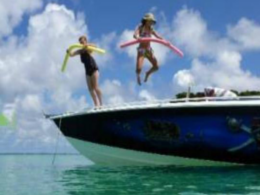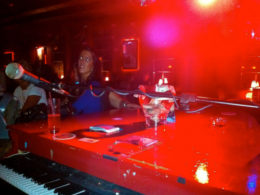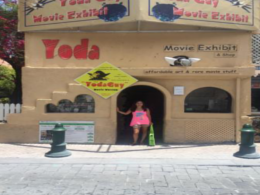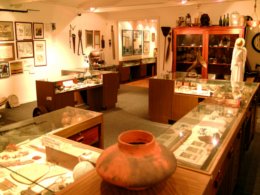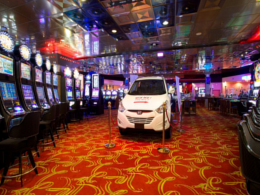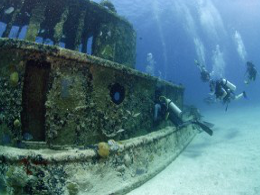Saint Martin is an island in the northeast Caribbean, approximately 300 km (190 mi) east of Puerto Rico. The 87-square-kilometre (34 sq mi) island is divided roughly 60/40 between France (53 km2, 20 sq mi) and the Kingdom of the Netherlands (34 km2, 13 sq mi); the two parts are roughly equal in population though, with slightly more people living on the Dutch side. It is the smallest inhabited island divided between two nations. The division dates to 1648. The southern Dutch part comprises Sint Maarten and is one of four constituent countries that form the Kingdom of the Netherlands.
The island is home to busy resort beaches and secluded coves. It's also known for fusion cuisine, vibrant nightlife and duty-free shops selling jewelry and liquor.
Population: 74,852
Area: 33.59 mi²
Capital: Philipsburg
Languages: French
Currency
The two official currencies on St. Martin are the Euro on the French side and the Florin (Netherlands Antillean guilder or florin) on the Dutch side.
US dollars are also accepted across the island.
There are many change points and banks on St. Martin.
Be aware that many places do not accept cheques from foreing cheques but most will accept major credit cards.
Climate
Under the Köppen climate classification, the island has a tropical monsoon climate with a dry season from January to April and a rainy season from August to December. The precipitation patterns are due to the movement of the Azores high during the year. With the wind direction predominantly from the east or the northeast, temperatures remain stable throughout the year and temperatures rarely exceed 34 °C (93 °F) or fall below 20 °C (68 °F). Temperatures remain steady throughout the year with an average mean temperature of 27.2 °C (81.0 °F). The average sea temperature is 27.2 °C (81.0 °F) ranging from a low of 25.9 °C (78.6 °F) in February to a high of 28.4 °C (83.1 °F) in October. The total average yearly rainfall is 1,047 mm (41.2 in), with 142 days of measurable rainfall. Thunderstorms can occasionally occur, with 18 days with thunder per year. Precipitation totals are quite variable from year to year, depending on the number of passing tropical storms and hurricanes.
Health
No vaccinations are required to enter the island.
Situated between the Tropic of Cancer and the Equator, Saint Martin receives the full force of the Caribbean sun. A high-SPF sunscreen is essential and sunblock is recommended for those that are not used to the intense sunlight.
A good pair of sunglasses and a hat are strongly recommended.
Dengue is a viral disease transmitted by the Aedes mosquito (Aedes aegypti in the Caribbean) that manifests itself as a high fever accompanied by headache, muscle and joint pain and weakness, which may last for several weeks. Symptoms appear two to seven days after a bite from an infected mosquito. In most cases, Dengue does not present complications. Nevertheless, mainly due to a low platelet count, this viral infection carries a risk of haemorrhage. You should ensure that you protect yourself from mosquito bites. If in doubt, consult a general practitioner immediately and avoid taking aspirin or anti-inflammatories.
According to the "Direction de la Santé et du Développement Social" (DSDS) there have been no recorded cases of Chikungunya or bird flu on the island to date. Protect yourself from mosquito bites by using mosquito nets, wearing long clothing and using repellents (citronella) and sprays.
Prevent the proliferation of carriers by eliminating reproduction sites indoors and outdoors.
Though the island is generally a safe place, like everywhere else in the world there is crime, and you should be aware of your surroundings at all times. Obviously you should lock your doors, avoid unpopulated areas and do not flash your money and jewelry around. Remember that this is a foreign country, and act accordingly. Tourists report many instances of parked rental cars being rifled. Organized teams can break in effortlessly. Best advice: Leave nothing of value in them at any time.
Like most places, drugs are readily available for those interested, but despite what someone may tell you Marijuana is not legal and certainly is not regulated as in certain parts of the Netherlands.
Transportation
Taxi cabs are usually vans, which are geared towards servicing the cruise ship traffic. Taxis do not have meters but charge according to a fixed fee. Some taxis, especially those on the Dutch side, only accept US dollars.
Saint Martin has a bus system using small minivans. You can recognise the vans because in the front window they will have a sign stating their direction and their license plate says bus. They run frequently between Philipsburg and Marigot. There are stops that the buses will stop at when someone is there, but you can flag one down from just about anywhere they can pull over as well as ask them to stop anywhere they reasonably can. They aren't exactly efficient or timely they show up essentially whenever but are a great way to get a leisurely tour for next to nothing and to get from the Dutch side to the French side.
Popular Car Rentals: Kayak, Avis, Thrifty, Hertz.
Top Beaches
Long Bay
Located in the heart of the Low Lands on the western coast of the island, Baie Longue, or Long Bay, is the first beach on French Saint Martin when travelling north from the Dutch side.
One of the longest beaches on the island, Baie Longue stretches from La Samanna's Hotel Resort on the left to "Pointe du Canonnier" on the right. It is also one of Saint Martin’s quietest beaches, with only the gentle lapping of the waves to disturb you.
Plum Bay
It is in the Low Lands area,between "Pointe du Canonnier" and "Falaise aux Oiseaux", Baie aux Prunes or Plum Bay is a secluded and rarely visited beach.
With golden sands and water in every shade of blue under the sun, Plum Bay is perfect for visitors looking for peace and harmony.
This magnificent beach is quite wild and not much frequented, but offers two features:
In calmer seas it provides the perfect setting for snorkelling; with a good swell it becomes an adventurous playground for experienced surfers.
Red Bay
Taking its name from its slightly coloured sand, Baie Rouge or Red Bay is without a doubt one of the most beautiful beaches on Saint Martin and one of the most popular. Small beach restaurants cater for your dining needs.
The beach is lively and has a pleasant atmosphere. Competent swimmers will enjoy swimming through the small rock arch, where a small secluded beach awaits at the base of the cliffs.
Petite Baie
Petite Baie beach (Little Bay), which lies across from "Baie de Marigot" (Marigot Bay), is rarely visited because it is largely exposed to the forces of nature in bad weather.
Grand-Case Beach
Located at the heart of the picturesque fishing village that bears its name, Grand Case Bay is a long beach at the foot of celebrated gourmet restaurants and smaller renown traditional eateries, known as lolos. Grand Case Bay is sheltered and the Caribbean blue waters there are calm and clear. Divers will enjoy exploring the famous Creole Rock.
Maho Beach
Maho Beach is a beach on the Dutch side of the Caribbean island of Saint Martin, in the territory of Sint Maarten. It is famous for the Princess Juliana International Airport adjacent to the beach. Due to the unique proximity of low flying airliners, the location is very popular with plane spotters. This is one of the few places in the world where aircraft can be viewed in their flight path just outside the end of the runway. Watching airliners pass over the beach is such a popular activity that daily arrivals and departures airline timetables are displayed on a board in most bars and restaurants on the beach, and the Sunset Bar and Grill formerly had a speaker on its outside deck that broadcast radio transmissions between pilots and the airport's control tower.
Mullet Bay
Mullet Bay is a large white sand beach, with slow rolling curls of waves coming in the beautiful, moon shaped bay. Its active surf makes this an attractive spot to local surfers. It is located next to the only island golf course and a resort destroyed by a hurricane many years ago. Mullet Bay is one of the prettiest beaches on Sint Maarten. It fits the picture of a tropical beach: wide and flat with a stand of palm trees on the fringe. The backdrop of seagrapes gives an additional cooling natural shade to this travel catalogue-like beach. Especially on weekends you also may see local families doing barbecues on the beach.
Orient Bay
Orient Bay, or in French "Baie Orientale", sweeps around a blue cove, facing east, as the name suggests. The 2 mile long, white powdered sand beach is protected from the Atlantic waves by a reef, and the bottom has a very gradual slope. Orient Beach is the most developed, the most popular and the busiest beach on the island, probably the most famous beach in the entire Caribbean. The beach is reputed as much for its natural beauty and setting as it is for being the island´s foremost swimsuit optional beach.
Great Bay
The waters are clear and calm. Great Bay is excellent for swimming, but is also a favorite place for beach strollers, as you can watch the coming and going of cruise ships in the harbor. Great Bay is conveniently located for vacationers staying in one of the hotels, resorts or guesthouses in downtown Philipsburg. Same is true for the (cruise ship) shoppers who´d like to combine a day of bargains and lazying by the beach or hanging out at one of the casual bars.
Le Galion Beach
Le Galion Beach, also called Coconut Grove, Baie de L´Embouchure, and nicknamed "Baby Beach", is the next bay Southeast of buzzling Orient Bay. This laid back beach is surrounded by a coral reef that serves as a protection, providing calm and shallow waters to Le Galion. You can wade 20 or 30 yards into the water, and your bath trunks are still not wet. It is a wonderful, low-key beach with a quiet and calm surf, perfect to visit with pre-school children. The beach is serviced by a couple of beach restaurants and watersport shops, namely "Chez Pat" and "Tropical Wave".
Accommodation
Activities






